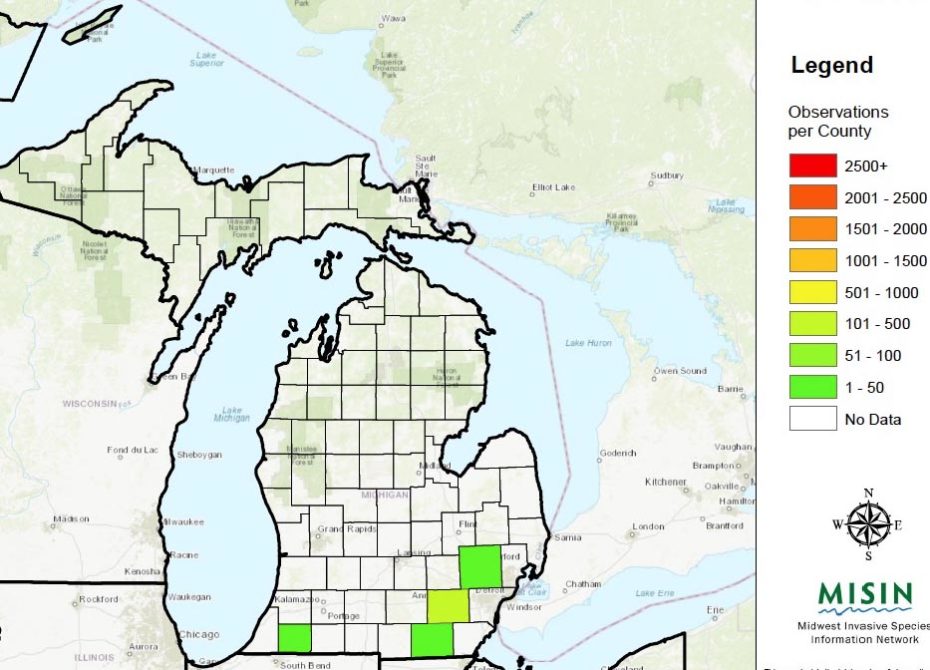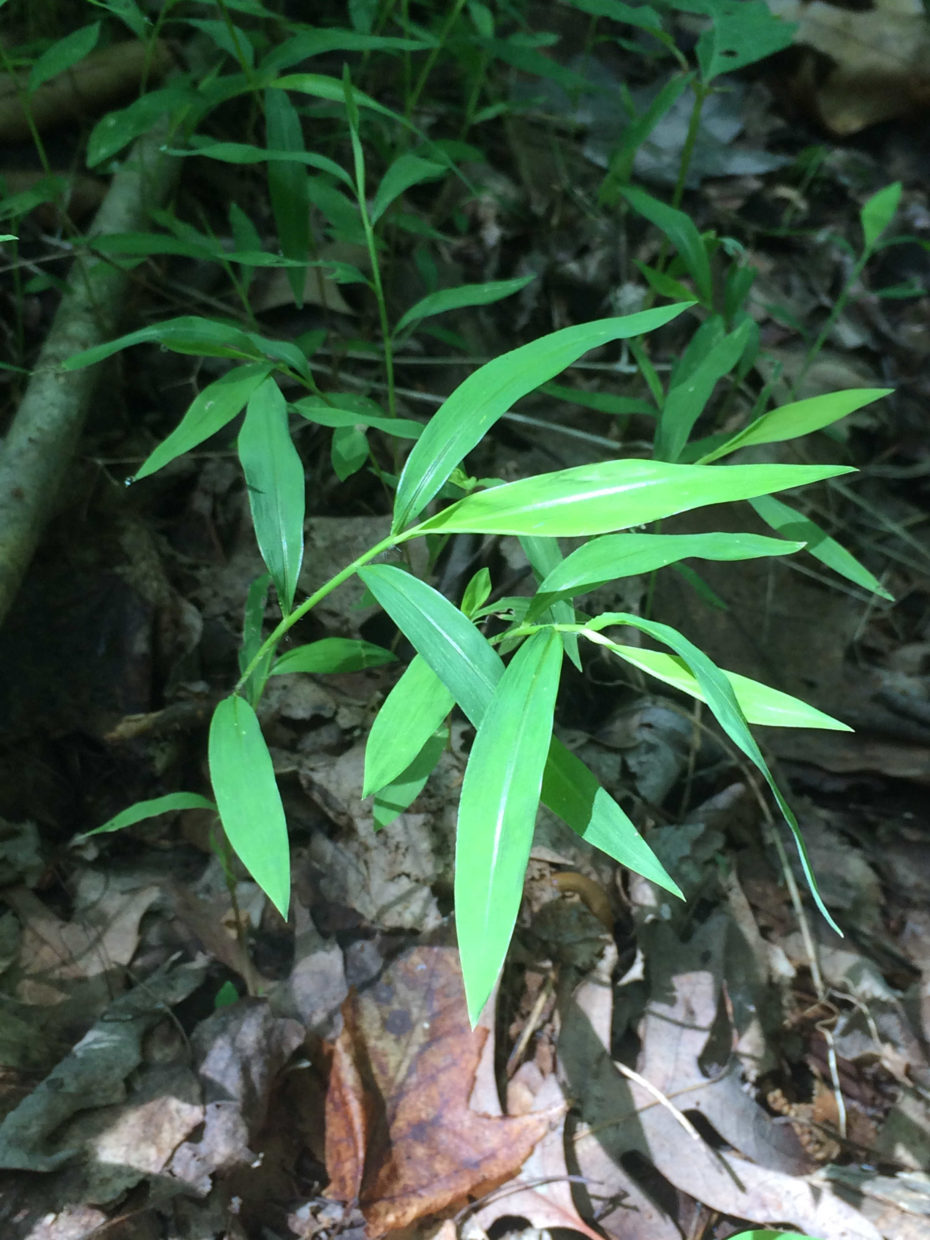(commonly known as Japanese stiltgrass, packing grass, or Nepalese browntop)
Scientific name: Microstegium vimineum (Trin.) A. Camus
“Microstegium vimineum is listed by the US Forest Service as one of only 26 Category 1 invasive plants in the Eastern Region of the USA; these are described as highly invasive plants which invade natural habitats and replace native species (https://onlinelibrary.wiley.com/doi/10.1111/epp.12276). Furthermore, M. vimineum was recently ranked as the number one invasive plant of concern by researchers and land managers in the Eastern USA.” – OEPP/EPPO Bulletin (2016) 46 (1), 14–19: Microstegium vimineum (Trin.) A. Camus
Arriving as packing material for Asian porcelain, stiltgrass was first identified in 1919 by Entomologist George G. Ainslie in Knoxville, TN. Recycling it as feed was unsuccessful, as all ruminants rejected it. Stiltgrass was thus loosed onto an unsuspecting continent.
This sprawling grass can grow in almost any environment. It produces copious small seeds that spread through water runoff, wildlife (especially deer), foot and vehicle traffic, and lawnmowers. Stiltgrass can choke out native flora within three years. Since 2017, it has been found on 50 Scio Township and 2 Ann Arbor properties, and in Lenawee, Cass, and Oakland counties.
Two elements make stiltgrass difficult to control:
(1) Initial small patches blend in with native grasses and sedges in woodland edges and easily escape detection. Then, snow melt and spring rains allow seeds to flow downhill and into streambeds and turn a patch into a multi-acre infestation in one year.
(2) Seedlings emerge in early June after the native grasses and ferns are tall and after the Spring Invasive Species Challenge occurs.
Microstegium vimineum differs from our familiar invasives in its speed and stealth. Controlling it in Michigan will require vigilance and truly rapid response.
Stiltgrass seedlings appear in Michigan around Memorial Day and inflorescence around Labor Day.
If you have Stiltgrass, you should report it online at www.misin.msu.edu, or download the MISIN smartphone app and report it from your phone.
Stiltgrass sample |
Map of Stiltgrass sightings (2019)
 |
Guides and Research
Learn to see what you hope is not out there—but then deal with it.
Stiltgrass ID and its Look-a-Likes
Field Guide to the Identification of Japanese Stiltgrass with comparisons to other look-a-like species
A joint effort between the River to River Cooperative Weed Management Area, the Alabama Cooperative Extension System, and the UGA Center for Invasive Species and Ecosystem Health. Very useful photographs and detailed description of structure, growing habits, and habitats. (revised March 2019)
MISIN Educational Module and Assessment: Japanese Stiltgrass
Phyllis Higman of MISIN has created an excellent training module. See in detail the various characteristics of stiltgrass, comparisons with similar grasses, and assessment of risks. You can even take a quiz!
Best video comparison of Leersia and Microstegium
Our native Leersia v. (cutgrass or sweetgrrass) is perhaps the most similar to Microstegium v. The best comparison of the two was done by Les Mehrhoff in his keynote speech for the 2010 Stiltgrass Summit (somewhat after the 20 minute mark).
2016 EPPO Bulletin (European and Mediterranean Plant Protection Organization)
This datasheet emphasizes that stiltgrass is an invasive of global concern. Concise summary of means of spread, environmental and social impacts with useful references.
Control and Monitoring
Controlling Non-Native Invasive Plants in Ohio Forests: Japanese Stiltgrass
This 2011 fact sheet from the Ohio State University addresses identification, spread prevention, mechanical and chemical control.
PennState quicksheet
This document emphasizes chemical controls based on season.
U.S. Department of Agriculture paper on Japanese Stiltgrass (including fire effects)
Informational and research material covering: Distribution and Occurrence, Botanical and ecological characteristics, fire effects and management, and management considerations. It is a 2011 paper from the U.S. Department of Agriculture, Forest Service, Rocky Mountain Research Station, Fire Sciences Laboratory.
Mowing Any Time after Midsummer Can Manage Japanese Stiltgrass
Angela L. Shelton paper from Invasive Plant Science and Management 2012 5:209–216
Invasive plant removal method determines native plant community responses
Flory, S.L. and K. Clay. 2009. Invasive plant removal method determines native plant community responses. Journal of Applied Ecology. 4:434-442.
Japanese stiltgrass management for woodland owners
Russ Richardson 2009. Two pages provide detailed advice on preventing the spread of stiltgrass in woodlands.
Fire and non‐native grass invasion interact to suppress tree regeneration in temperate deciduous forests (2015)
Areas of heavy stiltgrass thatch burn hot enough to discourage native tree and plant regeneration, but controlled burns do not reduce invasive plant biomass.
Conferences and Webcasts
Causes and Consequences of Microstegium vimineum (Japanese Stiltgrass) Invasion
Luke Flory actually did his dissertation on stiltgrass in Indiana. This 2010 webcast highlights his early research.
A Conversation on Japanese Stiltgrass
By 2017 Luke Flory had become an international figure in stiltgrass research and management. He joined the MIVI in Scio team of Jim Odell and Andrea Matthies for this update on his research and the documentation of stiltgrass in Scio Township in August 2017.
A Conversat Strategic Management of Stiltgrass in the Wake of Early Detectioion on Japanese Stiltgrass
One of the biggest conundrums any land manager / property owner / community faces is how to respond to the early detection of an aggressive invasive species. Becky Gajewski (Stewardship Specialist for the Natural Area Preservation (NAP) division of the City of Ann Arbor’s Parks and Recreation Services Unit) and Katie Carlisle (Stewardship Coordinator at Washtenaw County Parks and Recreation Commission) in this 2019 webcast.
August 2010 Video: 2010 Stiltgrass Summit
This lists all the conference presentations and provides web links to each presentation.
White Paper: 2010 Stiltgrass Summary
This summarizes the main points made at the two-day conference in a 27-page document with useful references.
Key Research Websites
The Flory Lab
Since his doctoral work at Indiana University, Luke Flory now oversees research in the Flory Lab at the University of Florida. His research covers a wide variety of topics in plant and ecosystem ecology with a focus on non-native plant invasions and agroecology–particularly stiltgrass. He has become an international authority on stiltgrass. Many of these articles can be downloaded and some cannot.
USDA Forest Service Stiltgrass (MIVI) Research
Many of our forests are managed by the USDA Forest Service and it has funded numerous research projects and forums on stiltgrass. All available can be downloaded.

